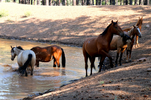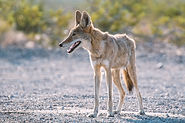Gray Fox
Urocyon cinereoargenteus

Look near forest edges at night
The gray fox is a small, agile member of the dog family, recognized by its grizzled gray coat, reddish legs, and black-tipped tail. Unlike most canids, it is an excellent climber and is the only fox in North America that can scale trees, often escaping predators or foraging among branches. Gray foxes inhabit a wide range of environments in Arizona, from desert scrub and chaparral to oak woodlands and forested canyons. They are omnivores, feeding on small mammals, birds, insects, fruits, and berries, adapting their diet to what is available throughout the seasons. Mostly nocturnal, they are shy and elusive, though occasionally seen during the day. Their ability to climb, coupled with their versatility in habitat and diet, makes the gray fox one of Arizona’s most adaptable predators, blending into both rugged wilderness and transitional landscapes.
Mammal

Identification & Behavior
Key Features: Gray fur with reddish sides, bushy tail with black tip
Size: 32–45 in, 7–15 lbs
Behavior: Shy, often seen at night with glowing eyes
Diet: Omnivore — rodents, birds, fruit, insects
Activity Pattern: Nocturnal
Habitat & Distribution
Found statewide in woodlands, desert scrub, and canyon habitats. Often near riparian areas and rocky slopes such as the Salt River Canyon, Mogollon Rim, and Sky Islands of southeastern Arizona. Present in Coconino, Prescott, Tonto,, Coronado National Forests, Apache-Sitgreaves National Forests.
Elevation Range: 3,000–9,000 ft
Seasonal Presence: Year-round
Risks & Management
Do not approach – can carry rabies









































